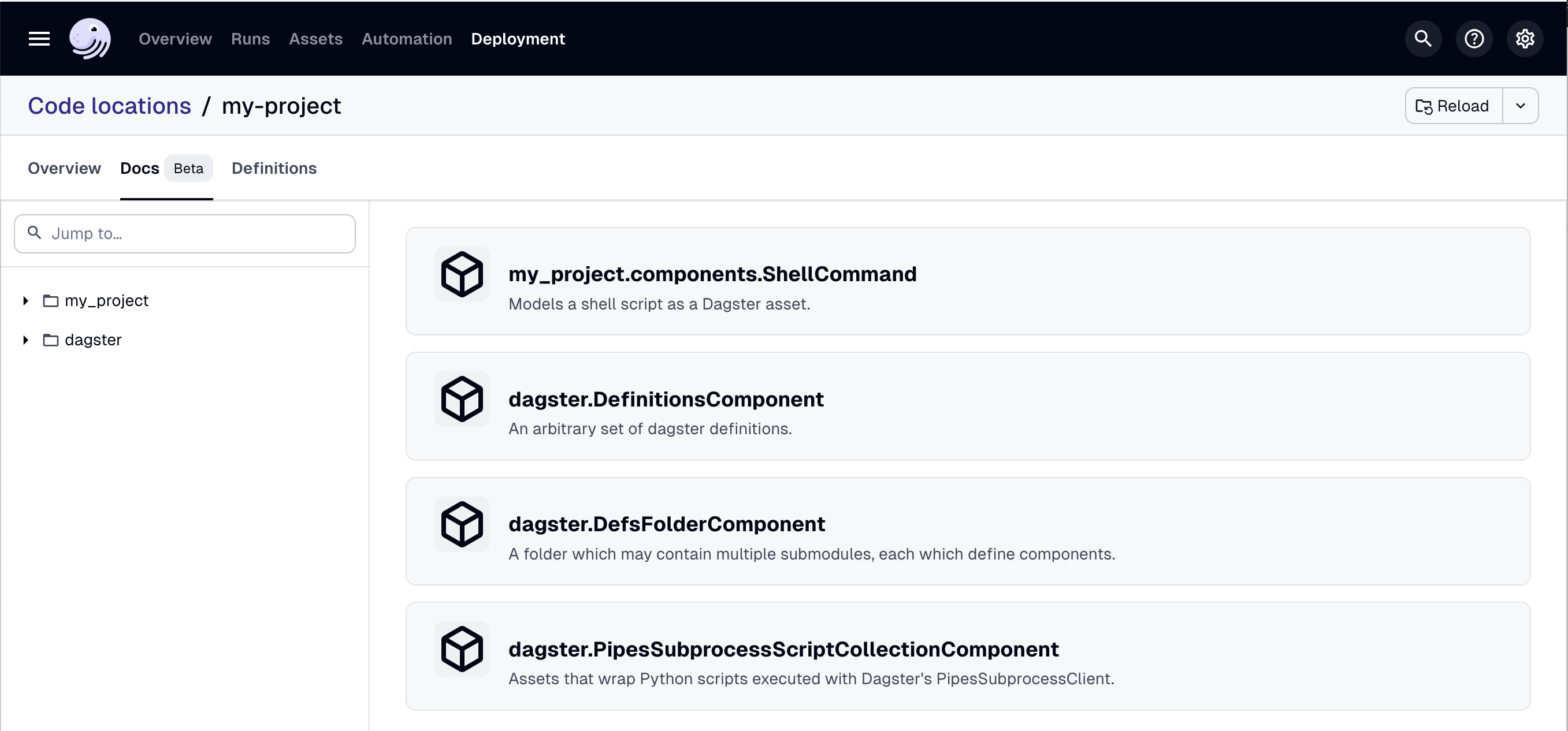Adding Dagster Component definitions to your project
You can scaffold Dagster Component definitions in your project from the command line with the dg scaffold defs command, which will create a new directory inside your defs/ folder that contains a defs.yaml file.
Before scaffolding a component definition, you must either create a components-ready Dagster project or migrate an existing project to dg.
Viewing available components
You can view the available components in your environment by running the following command:
dg list components
If the component you want to use is not available in your environment, you will need to install it with uv add or pip install. For example, to install the dbt project component, you would run:
- uv
- pip
uv add dagster-dbt
pip install dagster-dbt
For more information on integrations available as Dagster components, see the integrations documentation.
Viewing component documentation
To see automatically generated documentation for all components in your environment, you can run dg dev to start the webserver and navigate to the Docs tab for your project's code location:
dg dev

Scaffolding a component definition
Once you've decided on the component that you'd like to use, you can scaffold a definition for it by running dg scaffold defs <component> <component-path>. This will create a new directory inside your defs/ folder that contains a defs.yaml file.
For example, to scaffold a dbt project component definition, you would run:
dg scaffold defs dagster_dbt.DbtProjectComponent jdbt --project-path dbt/jdbt
Some components may require different arguments to be passed on the command line, or generate additional files when scaffolded.
You can run dg scaffold defs from within any directory in your project and the resulting files will always be created in the <project-name>/src/<project_name>/defs/ folder.
Python-formatted component definitions
To scaffold a component definition formatted in Python instead of YAML, you can use the dg scaffold defs command with the --format python option. For example, the following command will generate a component.py file for the dbt project component rather than a defs.yaml file:
dg scaffold defs dagster_dbt.DbtProjectComponent jdbt --project-path dbt/jdbt --format python
cd src/hello_world && tree
.
├── __init__.py
├── definitions.py
├── defs
│ ├── __init__.py
│ └── jdbt
│ └── component.py
└── lib
└── __init__.py
import dagster as dg
from dagster_dbt import DbtProjectComponent
@dg.component_instance
def load(context: dg.ComponentLoadContext) -> DbtProjectComponent: ...
Configuration
Basic configuration
defs.yaml is the primary configuration file for a component. It contains two top-level fields:
type: The type of the component defined in this directory.attributes: A dictionary of attributes that are specific to this component. The schema for these attributes is defined by attributes on theComponentand customized by overridingget_model_clsmethod on the component class.
To see a sample defs.yaml file for your specific component, you can view the component documentation in the Docs tab of the Dagster UI.
Component templating
Each defs.yaml file supports a rich templating syntax, powered by jinja2.
Templating environment variables
A common use case for templating is to avoid exposing environment variables (particularly secrets) in your YAML files. The Jinja scope for a defs.yaml file contains an env function that can be used to insert environment variables into the template:
type: dagster_fivetran.FivetranAccountComponent
attributes:
workspace:
account_id: test_account
api_key: "{{ env.FIVETRAN_API_KEY }}"
api_secret: "{{ env.FIVETRAN_API_SECRET }}"
connector_selector:
by_name:
- salesforce_warehouse_sync
translation:
group_name: fivetran_data
description: "Loads data from Fivetran connector {{ props.name }}"
Multiple component instances in the same file
To configure multiple instances of a component in the same defs.yaml file, add another block of YAML with top-level type and attributes keys, separated from the previous block by the --- separator.
type: snowflake_lib.SnowflakeComponent
attributes:
account: "{{ env.SNOWFLAKE_INSTANCE_ONE_ACCOUNT }}"
password: "{{ env.SNOWFLAKE_INSTANCE_ONE_PASSWORD }}"
---
type: snowflake_lib.SnowflakeComponent
attributes:
account: "{{ env.SNOWFLAKE_INSTANCE_TWO_ACCOUNT }}"
password: "{{ env.SNOWFLAKE_INSTANCE_TWO_PASSWORD }}"